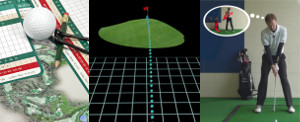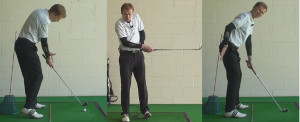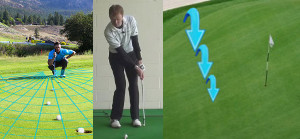If you watch professional golf on television, take notice of the similarities in their routines. Before hitting a shot, most all of them stand behind the ball calculating what they need to do and then visualizing it actually happen. They pick a specific target and become fixated with it. This method has been around the game for a long time and there is certainly evidence that it's a helpful process. If you don't have a pre-shot routine yet then develop one and stick with it for more consistency.

Wouldn’t it be great to be consistent on the golf course? You’d hit all of your shots in the general direction of the target, you’d hit solid putts time after time, and your scores would be pretty impressive round after round. That probably doesn’t sound much like the golf game you play currently, but it would be a welcome change.
Okay – so that kind of consistency probably isn’t in the cards. After all, you only have to watch a pro golf tournament on TV for a few holes to know that even the top players hit bad shots from time to time. While perfect consistency is just not something that happens in this game, you can strive to improve your consistency such that you shoot lower scores and have more fun on the course. In this article, we are going to talk about what it takes to be consistent, both from a physical and mental perspective. With any luck, you’ll be able to apply some of the ideas below to your own game, and you’ll start to notice that fewer and fewer mistakes are disrupting your good time on the course.
All of the content below is based on a right-handed golfer. If you happen to play left-handed, please take a moment to reverse the directions as necessary.
— How to Measure Consistency in Golf
| GOLF FIXES BY PGA PROS |
|---|
| Better Consistency – Use Your Shirt Buttons For Timing | Video | Article |
| Improve Your Golf Shot Consistency – Eyes Under Shaft Line At Finish Lesson | Video | Article |
| Build A More Controlled Backswing For More Consistency | Video | Article |
| Troubleshooting – Iron Consistency | Video | Article |
| Creating Consistency During The Golf Swing | Video | Article |
| Improve Your Golf Swing Tempo To Gain Power And Consistency | Video | Article |
| Improving The Consistency Of The Set-Up For Consistent Golf Swing Paths | Video | Article |
| Why and How Ladies should keep their Left Arm Straight during their Golf Swing for Consistency | Video | Article |
| LESSONS |
|---|
| Muscle Memory Key To Golf Consistency | Video | Article |
| Does A Shorter Golf Swing Provide More Consistency | Video | Article |
| A Steady Mood For Creating Golf Consistency | Video | Article |
| Iron Consistency A to Z Lesson | Video | Article |
| Basic Wide Takeaway Left Arm Inline With Shaft, Senior Consistency Golf Tip | Video | Article |
| Consistency Throughout The Golf Bag | Video | Article |
| Grooving A Smooth Rhythm To Improve Consistency Of Golf Strike | Video | Article |
| Learn Your Club Yardages to Improve Consistency, Golf | Video | Article |
| Muscle Memory Key To Golf Consistency – Basics Of Practice | Video | Article |
| Pre-Putt Routine Can Aid Consistency | Video | Article |
| Muscle Memory Key To Golf Consistency – How To Practice On The Range | Video | Article |
| The Mental Side Of Golf: Correct Muscle Memory is Necessary to Golf Consistency | Video | Article |
| Muscle Memory Key To Golf Consistency – Practice Under Pressure | Video | Article |
| Muscle Memory The Key To Golf Consistency – Success Under Pressure | Video | Article |
| Short Game Consistency Techniques | Video | Article |
| A few chipping points to improve your golf consistency | Video | Article |
| PRACTICE DRILLS |
|---|
| Improve Consistency With This Great Rotational Drill | Video | Article |
| Connection Drill To Help With Consistency | Video | Article |
| GOLF QUESTIONS |
|---|
| Golf Fundamentals, Can It Improve my Consistency? | Video | Article |
| What Should I Work On To Improve My Consistency? | Video | Article |
In order to improve anything about your golf game, you need to find a way to measure it. After all, if you can’t take some kind of objective measurement of what you want to improve, how will you know when you are making progress? In this section, we are going to identify a few different ways to measure your consistency and discuss the pros and cons of each option. How you wind up evaluating your own consistency is up to you, but hopefully these ideas will get you started.

- Scores. This is perhaps the easiest option of all, since you are going to keep score each time you golf anyway. If you track your scores from round to round, or if you keep a registered handicap where your last 20 scores will be stored, you’ll be able to easily see how consistent you are from round to round. Are most of your scores within a few strokes of one another, or are there wild variances from one round to the next? The nice thing about using your scores to check on consistency is that it’s an easy statistic which you probably have available anyway. On the downside, there are a lot of other variables that can influence your score which may or may not have anything to do with your personal consistency. For instance, changing weather from one round to the next can make a big difference, and so too can playing different courses with varying degrees of difficulty. For most players, scores will serve as a good starting point for a consistency evaluation, but they will not be enough all on their own.
- Fairways and greens hit. If you do bother to keep track of any stats as you play golf, it’s likely that your total number of greens and fairways hit is what you will monitor. These are easy stats to track, of course, as you can just make a note on your scorecard as you move along before adding them all up at the end. No one hits every fairway or green, but hitting high percentages in these two categories is a good sign that your play is consistent. Tracking these stats for just one round won’t do you much good, but keeping tabs on them as the rounds add up will be useful for monitoring trends in your ball striking. For instance, if you have been working on your swing technique but you don’t find that your greens hit percentage is actually improving, you may not be working on the right things. Just as with tracking your scores, monitoring your fairways and greens hit is an easy task, but it is again subject to some of the same issues as your scores. You may play some courses with wide fairways and others with narrow fairways, so your stats will fluctuate based on that external factor. The same thing can be said for greens. If you would like to count fairways and greens during each round, feel free to do so but understand that the value of these stats is somewhat limited.
- The ‘good shot’ metric. This last option on our list is certainly the most subjective, but it just might be the most useful in the long run. Rather than watching the trends of your scores, or counting up fairways and greens hit, you can choose to simply decide after each swing whether you hit a ‘good shot’. Of course, what constitutes a ‘good shot’ is going to vary from player to player, so it will be up to you to make that determination. Try playing a round where you keep your regular score on the scorecard, but you also have a line where you count up how many of your strokes you considered to be ‘good shots’. Why is this an appealing option? It gives you the ability to take a look at your performance while getting away from outcome-based evaluation. Let’s talk through an example hole to see why this method deserves your attention. Imagine you are standing on the tee of a long, difficult par four. You use your driver for the tee shot, and you hit a powerful shot down the left side of the fairway. The ball lands in the fairway, but after a few bounces and some roll, it comes to rest in the first cut of left rough. Most people would agree that you have hit a ‘good drive’, but the ball technically missed the fairway. Then, for your approach, you hit a high, accurate iron shot which lands near the cup and trickles onto the back fringe, only about 15-feet from the hole. Again, another ‘good shot’, but a missed green. So, if you were tracking fairways and greens, you’d be 0-for-2 on this hole – despite making two good swings and putting your ball in good positions to make a par or even a birdie. In this case, tracking your good shots would be a better representation of how you performed.
It’s up to you to decide how you would like to track your performance on the course. Some will like the simplicity of monitoring scores, while others will feel that something like the ‘good shot’ metric will be more useful. By tracking your consistency over time, you may notice patterns that allow you to make adjustments and take your game to a higher level.
— Causes and Cures of Physical Inconsistency
One of the many frustrating things about golf is the fact that it can be so difficult to replicate a good swing from one shot to the next. Many amateur golfers struggle with the reality that they aren’t able to just make the same swing over and over again. They will think, ‘if I hit that shot solid, why can’t I just do it again next time’?
For one thing, it’s important to accept that golf just works that way. The swing is a fast, dynamic action, and it’s hard to get all of the parts working together properly each time. With that said, it’s obvious that some golfers are more consistent than others. Professional golfers will make mistakes along the way, but they also are able to produce consistent swings throughout most of each round. How do they do it? Largely, it comes down to technique.
Below, we have listed a few technical points that can lead to inconsistency in the golf swing. If you can work yourself away from the issues listed below, you should find that your game quickly becomes more consistent from hole to hole and round to round.

- Poor balance. This is where the conversation is always going to start with regard to inconsistency. If you are unable to physically repeat your swing consistently, look first to your balance as a potential culprit. With poor balance, you’ll have a hard time delivering the ball accurately into impact with regularity. Sure, you will strike one cleanly from time to time, but you will always struggle to be as consistent as you would like. Commonly, poor balance stems from sliding away from the target during the backswing, only to slide back to the left in the downswing. Some players think this is how the swing action should work, but the golf swing is actually much more rotational than it is lateral. Work on improving your turn and limiting the amount of lateral action in your swing technique. With better balance, your consistency should improve dramatically, even if you make no other changes.
- Hands too active. Along with balance, this is another big consistency issue. Generally speaking, it is easier to repeat movements with your big muscles than your small muscles. So, if you use your hands actively in the swing, you’ll have a harder time being consistent than if you use big muscle groups to guide the movement of the club. Now, this gets tricky, as you do need to use your hands to some degree to hit your shots. The trick is to find the right blend of hand and body action to leave yourself with a trustworthy, repeatable swing. This is going to look slightly different for each player, as some golfers manage more success with a ‘handsy’ swing with others. If you are struggling to find the right combination of hand action and body rotation, consider working with a teaching pro at your local course to make a plan for your swing technique.
- Inconsistent stance. This last point deals not with the dynamic part of your swing, but rather the static position you use before putting the club in motion. You should be able to reproduce the same stance over and over, as this ability will make it far easier to perform a consistent swing. If your stance varies too much from shot to shot, it will be virtually impossible to swing the club in a repeatable manner. How do you get better at taking a consistent stance? Practice, of course. Just like any other part of your game, you’ll need to work on your stance in practice if you want it to be reliable on the course.
If you feel that your physical game is not as consistent as it should be at the moment, it’s likely that either poor balance or overactive hands are to blame. Address these issues at the driving range and see if you can work your way into improved ball striking in the near future.
— The Mental Component
It’s easy to blame the physical side of your golf game when something goes wrong on the course, but don’t make the mistake of thinking that your mental game is never to blame. Mental mistakes are extremely common in golf, and for some players, they are actually a bigger problem than physical errors. In this section, we’d like to highlight some mental game issues that may be contributing to your inconsistency.

- Lack of a plan. This is a huge issue for many amateur golfers. The game of golf is not as simple as just walking up to the ball and swinging away – even if that’s what it looks like the pros on TV are doing. In reality, each shot a professional golfer hits has a detailed plan, and you should approach your game in much the same way. Crafting a plan is going to make you more consistent because it will force you to think each shot through thoroughly – what are you trying to do with the ball? What hazards are you trying to avoid? By thinking the shot through, you’ll develop a plan that gives you a good chance to be successful. It’s important to understand that your plan isn’t always going to work out, and that’s okay. For some golfers, it’s tempting to give up on the idea of planning for each shot, since they fall short of 100% execution anyway. Don’t think this way. Even if your plans don’t always come together, they still have value and will make you a better overall player.
- Lack of belief. Low confidence in your ability to produce quality golf shots is a big piece of this puzzle. You are naturally going to be inconsistent if you don’t believe in yourself each time you step over the ball. Of course, this is one of the hardest hurdles for the average golfer to clear, as this is a difficult game and digging up confidence when you are used to seeing disappointing results is never easy. Building confidence starts on the practice range, so try setting specific goals for yourself while practicing. As you hit those goals with greater and greater regularity, your belief in your overall game will be improved – and so too will your consistency take a step forward. Not only will you benefit from being more consistent, but you should also find that you have more fun playing golf when you believe in your abilities. It’s far more enjoyable to stand over the ball expecting a good outcome than to expect the worse. The great thing about working on your confidence is that it tends to build momentum after you get started – eventually, you’ll feel like you are unstoppable!
- Overall distraction. The modern world is a distracted place. Wherever people are, it seems that they are paying attention to something else that is happening somewhere else. That issue extends to the golf course, where many players seem to struggle to muster the attention necessary to play this game properly. So, do you need to shut out the world around you in order to play golf well? Nope – not at all. The key is to learn how to move in and out of focus effectively. When it’s time to hit a shot, get down to business in figuring out the details of the shot and what needs to be done to send the ball to the target. Once that shot has been played, feel free to enjoy yourself by chatting with your playing partners, looking around at the scenery, or whatever else (as long as you keep up with the pace of place). By learning how to come in and out of focus at the right times, you can have fun on the course and still play well consistently.
It’s easy to let your mind get in the way on the golf course. For as much attention as most golfers pay to their physical issues with the swing itself, it would be wise for those same players to pay some attention to how they can improve their mental game.
— Short Game Consistency
To be consistent in the short game would be a dream come true for many players. Playing golf with a solid, reliable short game is a wonderful experience – yet it is one that most golfers never get to enjoy. The short game is a source of endless frustration for the average player, so finding some consistency in this area would be a great relief.
How can you get more consistent with your short clubs? The following tips may help get you started in the right direction.

- Speed, speed, speed. The key to consistency in the short game, especially with your putter, is speed control. You need to properly control the speed of your putts if you want to two putt on a regular basis and toss in your share of one putts along the way. The first thing you do to get ready for any round of golf should be to work on learning the speed of the greens for the day. The line is obviously an important part of every putt as well, but getting the speed right will make your life much easier on the course.
- Contact is key for chipping. It’s pretty easy to make good contact with the ball when you are putting, but that task gets much more difficult when hitting a chip shot. To chip the ball accurately over and over again, you need to make clean contact as often as possible. During practice, give yourself a variety of different lies and make it your goal to strike the ball as cleanly as you can. A clean strike will be easier to achieve if you keep your head still and keep your hands moving through the hitting area. You’ll be surprised at how much more confident you feel on the course when chipping if you have spent some practice time developing this skill.
- Play the smart shot. Part of improving your consistency around the greens comes down to making good decisions. For instance, when faced with a particularly difficult chip shot from a bad lie, play it safe and give yourself plenty of margin for error with your target. If you try to pull off the perfect shot and it doesn’t work out, you may be chipping again – and a big number could be just around the corner. Instead of taking on such a risk, try to chip the ball into the big part of the green and take your chances with your putter. Being patient and making good choices can go a long way when trying to limit the number of shots you waste with a wedge or putter in your hands.
Are you going to head out for your next tee time and immediately be consistent from the first hole to the last, now that you have read this article? Probably not. Golf is a hard game and it is going to take plenty of practice to better yourself in this area. We do hope that the advice provided in this article will help you make progress, and that you’ll have more fun on the links as a result. Good luck!






